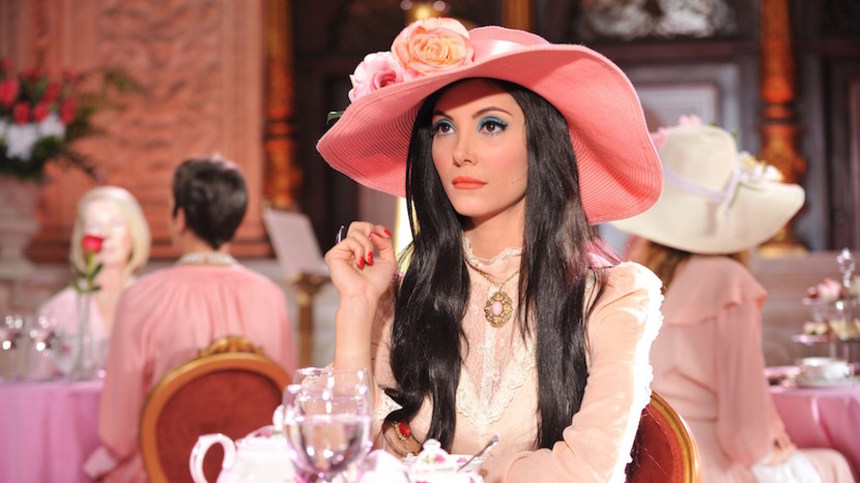Interview: Unpacking The Technicolor Radiance Of THE LOVE WITCH With Director Anna Biller

The Love Witch opened in Los Angeles this past Friday and premieres in New York next week. It was easily one of my favourite experiences in the cinema this year and it was a privilege to see it at the Australian Melbourne International Film Festival (MIFF). I had the gracious opportunity to flick a few questions that have been circling my mind to director Anna Biller. Her responses are below.
Kwenton (ScreenAnarchy): My partner is a practicing pagan witch, and she was very impressed with all the small details and how the belief was portrayed in the film in a non-derisive way. What research and experts were involved to ensure these aspects were faithful?
Anna Biller: I’m so glad the film passed the test with a real witch! It was very important for me to be realistic about the pagan community, so I did a lot of research. What I found was that most pagans today are peaceful and nature-oriented, so that’s how I portrayed the coven. I also included some darker elements that I found from ‘60s Alexandrian rituals and from the causal crossover that many Wiccans have with Satanists. I read a lot of books, from Margaret Murray to Janet and Stewart Farrar to Starhawk to Aleister Crowley, and I went to classes and rituals and lurked on pagan forums.
Elaine herself is a problematic protagonist. It's not the fact she is a witch, but a genuine sociopath scarred by the past. I found this to be a noir-like situation, except that it was from the Femme Fatale’s point of view. Which characters, fictional or not, inspired Elaine?
It’s exactly correct to say that Elaine is like a femme fatale in a noir film. I took most of the inspiration for Elaine from noir characters. Some of the characters that inspired me most were Larraine Day’s character in The Locket, Gene Tierney in Leave Her to Heaven, and Jean Simmons in Angel Face. All three of these characters are sociopathic women trying to get by in a man’s world. I love the psychological complexity of these characters. They all have this perfectly composed exterior but are raging inside, like Elaine. I also based Elaine on a pathologically narcissistic woman that I know personally, and on the concept of the women in The Stepford Wives.
The most recent example of cinema I can think of regarding the vibrant colours and vivid set design evident in your film hail from Japan and Korea. Did Asian cinema influence The Love Witch?
I don’t watch a lot of Asian cinema (except for some Bollywood films). I think my aesthetic comes more form the vibrant Technicolor films of Hollywood’s golden age.
How did you go about casting for the film?
I just put out a regular casting notice, and held auditions. In nearly every case, the right actor for each role was obvious, and I didn’t even need to hold callbacks! I think I must have really known what I wanted. It was a little harder to find my love witch, but once I found her I realized she was magically perfect.
Your style has been described as narcissistic feminism, could you please elaborate on what that means for you?
I haven’t heard that before! What that would mean to me is that I make films in which women can enjoy watching other women. So my films cater to a female gaze, which is a feminist concept.
Both The Love Witch and Viva use sex as power, and yet Viva is distinctly set in the ‘70s and reflects the sexual politics, while The Love Witch is wonderfully and confusingly contemporary retro. What led to that decision?
Viva was a commentary on the sexual revolution as depicted by Playboy magazine, so it had to be set at the peak of the sexual revolution. The Love Witch is about a woman using witchcraft as a tool of empowerment, which is more of a contemporary concept. So it is set in the present, but because of the style of design and lighting I use, which is inspired by classic movies, it has a retro feeling to it.
While the Love Witch is not outright horror, I would love to get your take on this new wave of Horror films directed by women. What do you think of this movement and what has recently caused it?
I love the fact that women are directing more films, period. And the horror genre is very popular right now, so it’s easier for them to get funding to make horror films. I’m not sure I’ve seen enough of them to make an assessment about whether or not there is any cohesion in terms of women’s as opposed to men’s horror films, but they seem at first glance to be more personal and more about human relationships.
Who are some of your favourite directors that inspired The Love Witch?
Losey, Bergman, Dreyer, Hitchcock, Sirk, Polanski, Buñuel, Jacques Démy, Pasolini, Preminger, and John Brahm.
I recall only tid-bits about the bluray release of the film, can you share what extras and goodies will be with the release?
First we are concentrating on the US theatrical release, which opens this weekend. The DVD and Bluray will be chock full of bonus materials, including deleted and extended scenes, Samantha Robinson’s dance audition, a behind-the-scenes featurette with commentary, a DVD commentary, trailers, and more!
What is next for you?
I’m working on a script that will draw more directly from my love of noir films, based on the traditional Bluebeard story.







